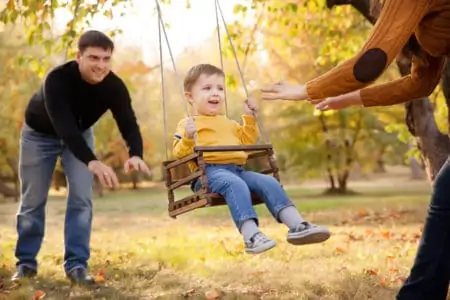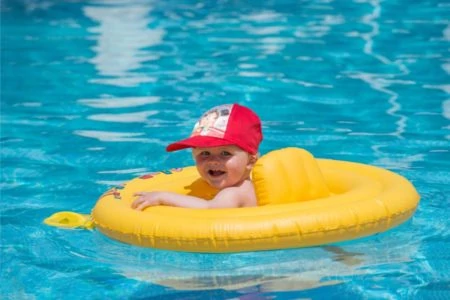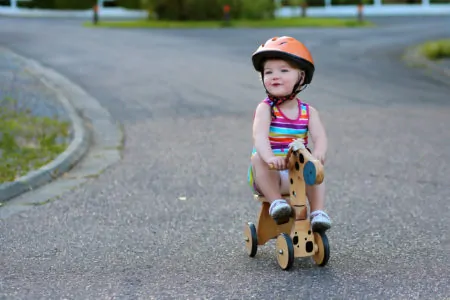If your new baby is hard to soothe, you are likely dreaming of the moment you can set them down and give your aching arms a break. But before you plug in that gear, you need to know: is it actually safe yet?
We know the struggle of trying to research safety guidelines while bouncing a fussy infant. We have compiled the answers regarding indoor and outdoor swing limits so you can get that much-needed rest safely.
Key Takeaways
- Always check your specific model’s manual for weight limits and age recommendations.
- Babies under 4 months must sit in the most reclined position to prevent suffocation.
- Never let your baby sleep in a swing; it does not meet safe sleep standards.
- Limit swing time to under 30 minutes per session (and 1 hour daily) to protect physical development.
When Can Babies Start Using a Swing?
Since indoor baby swings come in so many styles, the “start date” varies. You have to look at the incline, head support, and speed options.
To find the exact starting age for your gear, check the instruction manual. If you tossed that booklet months ago (we have all been there), search for the model number online to download a digital copy.
Generally, many swings are safe to use immediately after birth. However, the American Academy of Pediatrics (AAP) states that babies younger than 4 months should always use the most reclined position. This prevents their head from slumping forward and obstructing their airway (1).
When Should Baby Stop Using a Swing?
Like all helpful baby gear, the swing phase eventually ends. While age is a factor, your child’s weight and physical milestones are actually more important indicators.
Most motorized swings have a maximum weight limit of 30 pounds. Some compact travel models max out at 20 pounds, while heavy-duty options might hold up to 40 pounds. If you have a fast-growing baby, check these limits frequently.
You should stop using the swing immediately if:
- Your baby hits the weight limit: Exceeding this makes the swing unstable.
- They can sit up or crawl: Active babies might try to climb out, posing a fall risk.
- They hate it: If your little one cries every time you buckle them in, it is time to retire the gear.
Can Babies Sleep in a Swing?
No, babies should not sleep in swings. The AAP is clear: babies should always sleep flat on their backs on a firm, safety-approved mattress with only a fitted sheet (2).
When a baby sleeps at an incline, their heavy head can fall forward, cutting off oxygen. This is known as positional asphyxiation (3).
My third baby was a total party animal who suffered from serious FOMO. The only way I could settle him was by rocking, bouncing, or wearing him in a baby carrier. When I first put him in a swing, he passed out instantly. I was thrilled, but I quickly learned that the soft padding and incline made it unsafe for sleep.
I decided safety was more important than convenience. I let the swing calm him down, but once he drifted off, I moved him to his crib. It took extra effort, but knowing he was safe was worth it.
How Long Can Baby Stay in a Swing?
It is tempting to leave your baby in the swing while you catch up on chores (or Netflix). However, experts recommend limiting swing time to less than one hour per day (4). Ideally, stick to 15 to 30 minutes at a time.
Overusing “containers” like swings, bouncers, and car seats can lead to a few issues:
- Flat Head Syndrome: Also called plagiocephaly, this flattening of the baby’s head happens when the skull rests against a surface for too long without full range of motion (5).
- Delayed Milestones: Time in a swing is time not spent on tummy time or learning to roll. Excessive use can make it harder for your baby to reach milestones like sitting up, crawling, or walking.
Think of the swing as a temporary tool for soothing, not a place for your baby to hang out all day.
Baby Swing Safety Tips
Swings can be a parent’s best friend, offering a womb-like experience that calms a fussy infant. However, thousands of swing-related injuries occur every year (6).
Follow these guidelines to keep your little one safe:
- Check for recalls: If buying used, search the CPSC Recall List to ensure the model is safe.
- Register your product: If buying new, mail in the registration card so the manufacturer can contact you regarding safety updates.
- Inspect regularly: Ensure all pieces are present and securely fastened before use.
- Stay grounded: Never place a baby swing on a table, counter, or raised surface. The floor is the only safe place.
- Use the harness: Always buckle your baby in securely.
- Recline for newborns: Keep the seat fully reclined for any baby under 4 months old.
- Supervise constantly: Never leave the room while your baby is swinging.
- No napping: If they fall asleep, move them to a safe sleep surface immediately.
- Stop when mobile: Discontinue use if your baby tries to climb out or exceeds the weight limit.
When Can My Baby Go on a Park Swing?
As your baby outgrows their indoor glider, you might be eyeing those bucket swings at the local playground. But hold on; park swings are very different from indoor gear.
Outdoor swings keep babies in a rigid, upright position. To use them safely, your baby needs strong neck and back control. If they flop forward or sideways, they are not ready.
Most babies are ready for park swings around 6 to 9 months.
- The Test: Can your baby sit up independently without support? If yes, they are likely ready for a gentle push.
- Hypotonia: Babies with low muscle tone may need to wait longer or find an accessible swing with high-back support.
Be playful but cautious during that first ride. Some babies love the wind in their face, while others find the sensation overwhelming. If they cry, do not push it. Try again in a few weeks.
Baby Swing FAQs
These common questions will help you use your gear safely and effectively.
Know Your Limits
Swings can be a lifesaver for tired parents, but they are tools, not babysitters. Since there is no universal “magic age” for every model, you must verify your specific swing’s weight and developmental limits.
Remember: swings are for awake time, not sleep time. Keep your sessions short, keep your eyes on your baby, and enjoy those few minutes of hands-free freedom.









